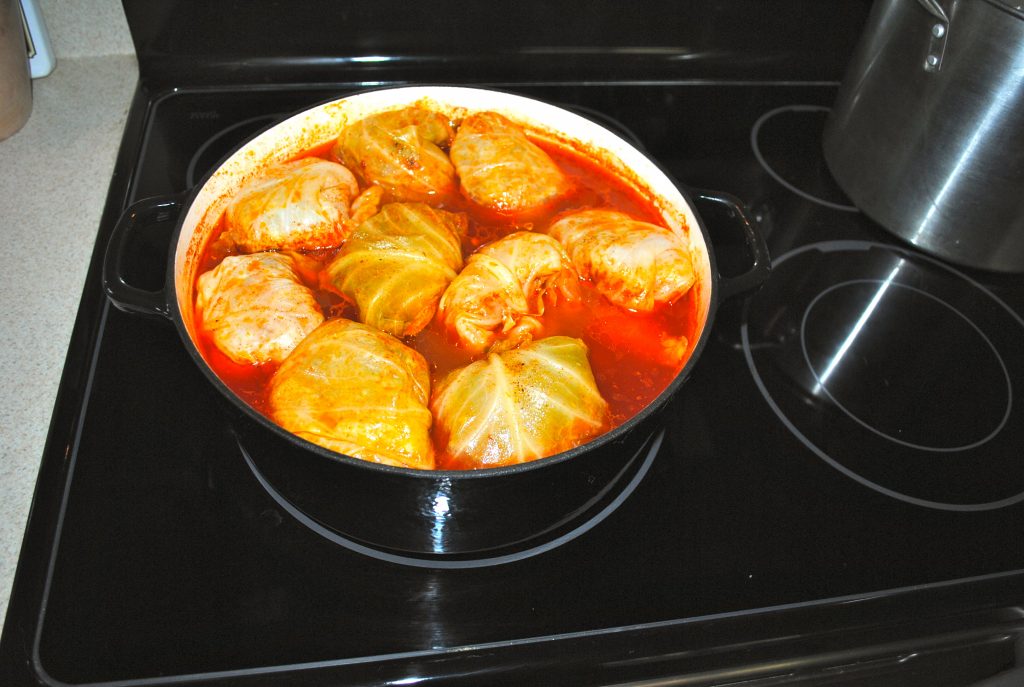Let’s have some gołąbki! Posted by Kasia on Nov 25, 2014 in Culture
I’m not a big cook…but I really enjoy cooking traditional Polish meals! I always kept telling my dad that my future husband will cook for me! He used to say: “You will never find a husband who will cook for you all the time!”
Well..I did…Although I really enjoy making traditional Polish meals! And my husband enjoys these nights when we have Polish dinners! One of his favorites are gołąbki! Gołąbki definitely remind me a lot about Poland..it was always my favorite dish! The history of traditional Polish stuffed cabbage begins in the nineteenth century. It comes from Eastern borderlands, from the vicinity of Tarnopol. Pigeons/Stuffed cabbage (gołąbki) were initially prepared as a Christmas dish with buckwheat and potatoes. Recipes passed from mouth to mouth, from generation to generation has evolved into a well-known forms – wrapped in cabbage minced meat with rice.
So today I would love to share my favorite recipe! It is almost like my mother used to make it…but I made few changes to make it my own:)
Składniki:
- 1 główka kapusty
- 1 szklanka ryżu
- 1 funt mielonego mięsa wieprzowego
- 1 funt mielonego mięsa wołowego
- 1 puszka koncentratu pomidorowego (0.5 uncji)
- 1 cebula
- 3 liście laurowe
- 2 łyżeczki vegety
- 1 łyżeczka pieprzu
- 1 łyżeczka soli
- Sos
- 2 łyżki mąki
- 1 puszka koncentratu pomidorowego
- 3 łyżki śmietany
Z kapusty wytnij głąb. W dużym garnku zagotuj osoloną wodę i włóż do niej główkę kapusty. Gotuj przez 10-15 minut. Wyjmij z wody i delikatnie oddziel liść po liściu. Odłóż je na bok (nie wylewaj wody w której kapusta się gotowała).
W międzyczasie ugotuj ryż (ugotuj na pół twardo, reszta ryżu dogotuje się w gołąbkach). Pokrój cebulę w kostkę i przysmaż na maśle.
W misce wymięszaj mięso mielone (wołowinę i wieprzowinę), koncentrat pomidorowy, ryż, sól, pieprz, vegetę , przysmażoną cebulę.
Z masy uformuj kulki (wielkość w zależności od wielkości liści) i zawijaj je w liście kapusty. Ułóż gołąbki w garnku. Teraz wodę pozostałą po gotowaniu kapusty użyj do zalania gołąbków. Ja przeważnie do tej wody dodaję sól, pieprz i odrobię koncentratu pomidorowego, oraz liście laurowe. Upewnij się że woda zakrywa wszystkie gołąbki. Gotuj na wolnym ogniu przez godzinę.
W międzyczasie zrób sos: mąkę rozmieszaj z obrobiną wody. Dodaj koncentrat pomidorowy i śmietanę, wymieszaj na jednolity sos na gorącej patelni.
Gołąbki podawaj z gotowanymi ziemniakami.
Smacznego!
Ingredients:
1 cabbage
1 cup of rice
1 pound ground pork
1 pound ground beef
1 can tomato paste (0.5 oz)
1 onion
3 bay leaves
2 teaspoons of Vegeta (Polish spice of mixed vegetables – can be replaced with any vegetable mix spice)
1 teaspoon pepper
1 teaspoon salt
sauce:
2 tablespoons flour
1 can of tomato paste
3 tablespoons sour cream
Cut the core of the cabbage out. In a large pot boil salted water and add the cabbage to it. Cook for 10-15 minutes. Remove from the water and gently separate leaf by leaf. Put them aside (do not pour out the water in which the cabbage is cooked).
Meanwhile, cook rice (cook half way through, rice will get fully cooked inside the cabbage rolls). Chop the onions and saute them on the butter.
In a bowl, mix the ground meat (beef and pork), tomato paste, rice, salt, pepper, Vegeta, sauteed onions.
Make meat balls (size depending on the size of the leaves) and wrap them in a cabbage leafs. Place them in a large pot. Now use the remaining water after cooking cabbage to pour over gołąbki. I usually add salt, pepper, a little bit of tomato paste, and bay leaves. Make sure the water covers all the gołąbki. Simmer for an hour.
Meanwhile, make the sauce: mix the flour with a little bit of water. Add tomato paste and cream and mix to a sauce in a hot pan.
Stuffed cabbage serve with boiled potatoes. Pour sauce over it.
Have a great meal!
Do następnego razu… (Till next time…)

Build vocabulary, practice pronunciation, and more with Transparent Language Online. Available anytime, anywhere, on any device.
About the Author: Kasia
My name is Kasia Scontsas. I grew near Lublin, Poland and moved to Warsaw to study International Business. I have passion for languages: any languages! Currently I live in New Hampshire. I enjoy skiing, kayaking, biking and paddle boarding. My husband speaks a little Polish, but our daughters are fluent in it! I wanted to make sure that they can communicate with their Polish relatives in our native language. Teaching them Polish since they were born was the best thing I could have given them! I have been writing about learning Polish language and culture for Transparent Language’s Polish Blog since 2010.





Comments:
Terukna:
They look delicious…Like the ones my Babcia used to make.